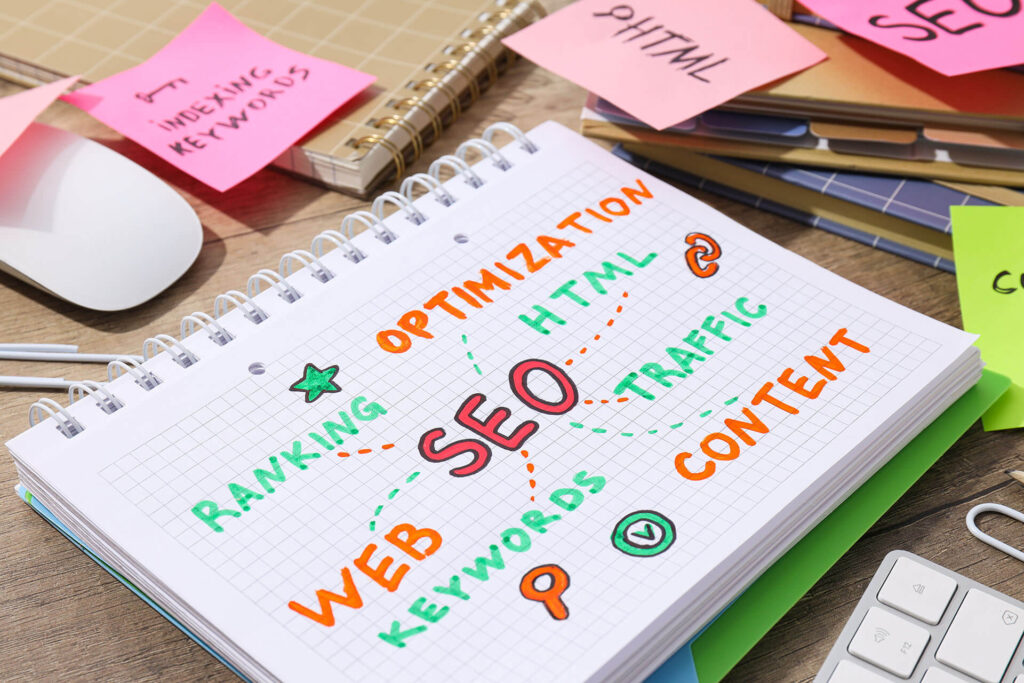In the ever-evolving world of search engine optimization (SEO), one question continues to occupy minds: how does Google determine what constitutes “helpful content”? Here are the key findings and how you can ensure your content meets these criteria. In addition, we discuss how Novonto can help you achieve these goals and avoid the negative impact of non-optimization.
Expertise, Authority and Reliability (E-A-T).
The concepts of Expertise, Authoritativeness and Trustworthiness (E-A-T) are crucial to content quality and ranking in search results. E-A-T is especially important for websites that focus on sensitive topics, known as Your Money or Your Life (YMYL), such as health care, finance and legal matters. The negative impact of a lack of E-A-T can be enormous and can manifest itself in a variety of ways. The following is a detailed explanation of the negative consequences of a lack of E-A-T.
1. Loss of Search Engine Ranking
One of the most immediate consequences of a lack of E-A-T is the loss of ranking in search engines such as Google. Google’s algorithms prefer websites that can demonstrate their expertise, authority and reliability. If a website cannot ensure these aspects, it will appear lower in search results. This means less visibility and less organic traffic to the website. Especially for YMYL-websites can have a serious impact, as users are looking for reliable and accurate information.
2. Loss of User Confidence.
Users rely on search engines to provide them with the most relevant and reliable information. If a website cannot meet the E-A-T-criteria, users are likely to lose confidence in the Web site. This can lead to lower user engagement, higher bounce rates and ultimately a decline in conversions. Users dissatisfied with the reliability of information will be less likely to return to the Web site or purchase products and services.
3. Dissemination of Misinformation
A lack of E-A-T can lead to the spread of misinformation, which is especially problematic for YMYL-subjects. Unreliable or inaccurate information can have serious consequences for users’ health, finances or well-being. For example, medical advice from unauthorized sources can lead to misdiagnoses or treatments. This can harm not only the individual user, but also the reputation of the Web site and even have legal consequences.
4. Negative Online Reputation
A lack of E-A-T can contribute to a negative online reputation. Websites that are not transparent about their sources, do not provide contact information or have inadequate security measures are seen as untrustworthy. Negative reviews and bad word-of-mouth can further damage a website’s reputation. This affects not only search results, but also the perception of the Web site by users and other stakeholders.
5. Increased Chance of Penalties by Google.
Google has made several updates and algorithm adjustments to improve the quality of search results, including the Core Updates and the Helpful Content Update. Websites that do not comply with the E-A-T-criteria are at increased risk of penalties, which can lead to a drastic drop in search engine rankings. These penalties are often difficult to fix and can have long-lasting effects on the website’s SEO performance.
6. Loss of Authoritative Backlinks.
Backlinks from reputable and authoritative websites contribute to a website’s authority. Websites that do not meet the E-A-T-criteria are less likely to earn backlinks from reliable sources. This can lead to a vicious cycle, where the lack of authority and reliability results in fewer backlinks, which in turn leads to lower rankings in search results.
Conclusion
Failure to comply with the E-A-T-criteria can have significant negative impacts on a website’s SEO performance, user trust, online reputation and overall success. It is essential for website owners and content creators to invest in improving their expertise, authority and trustworthiness to avoid this negative impact and achieve sustainable growth.
What is Semantic SEO and Why is it Important?
Semantic SEO is an advanced approach to search engine optimization that goes beyond just using specific keywords. It focuses on the meaning and context of search queries and content, allowing search engines such as Google to better understand what users really mean when they search online. This is achieved by analyzing the relationships between words, entities and the overall context of the search query.
Core concepts of Semantic SEO
- Entities and Knowledge Graph:
- Entities are the building blocks of semantic SEO and include core concepts, people, places, things or ideas relevant to a particular topic. Google uses the Knowledge Graph to understand the relationships between different entities and help deliver accurate search results.
- Keywords vs. Entities:
- Keywords are specific words or phrases that people use to search for information. Entities In contrast, broader concepts are those that reflect the deeper meaning and context of a search query. For example, the word “Jaguar” can refer to both an animal and a car brand, and semantic SEO helps search engines distinguish these dual meanings based on context.
- Google Algorithm Updates:
- Hummingbird (2013): Focuses on the intent behind searches and the meaning of words and phrases.
- RankBrain (2015): Uses machine learning to understand search queries and improve the relevance of search results.
- BERT (2019): Analyzes the interaction between words in a sentence to better understand complex searches and deliver more relevant results.
Benefits of Semantic SEO
- Better Relevance and User Experience:
- Helps search engines better understand user intent, leading to more relevant search results.
- Improves user experience by better matching content to user search intent.
- Increased Organic Traffic and Increased Conversions:
- By optimizing content for semantic search, you attract more targeted organic traffic, which can lead to greater online visibility and more potential customers.
- Offering content that closely matches user intent increases the likelihood of conversions.
- Future-proofing:
- Fits well with the developments of search engines and their ability to understand more complex searches, including voice search and mobile search.
Best Practices for Semantic SEO
- Publish Topically Relevant Content:
- Create comprehensive content that covers a topic in depth rather than focusing on a single search term.
- Use of Structured Data:
- Add structured data to your website to help search engines better understand the content. This can also lead to rich snippets in search results, which can increase your organic CTR.
- Optimize for Conversational Keywords:
- Use natural language in your content, which helps optimize for voice search and improve semantic SEO.
- Internal Linking and Semantic Markup:
- Provide a good internal link structure and use semantic HTML elements to clearly define the structure of your content.
Conclusion
Semantic SEO is essential for improving your website’s search engine performance by better understanding the context and meaning of search queries. By focusing on user intent and creating topically relevant content, you can not only improve visibility and relevance in search results, but also increase overall user experience and conversions.
Faster Load Times and Smaller HTML Size: Why and How?
A fast website is crucial for a good user experience and higher search engine rankings. Slow websites can drive visitors away, hurt your SEO performance and ultimately lead to missed revenue. Here are some methods and tips to improve your website load time and reduce HTML size.
Why Fast Load Times Are Important
- User Experience: Visitors expect pages to load quickly. Slow load times can lead to frustration and a high bounce rate.
- SEO: Search engines such as Google use loading speed as a ranking factor. Faster websites are often ranked higher than slower ones.
- Conversions: Fast websites have higher conversion rates. Every extra second of loading time can lead to a significant drop in conversions.
- Advertising performance: The speed of your Web site also affects the performance of paid advertising (SEA). Slow load times can cause higher ad costs and lower ad positions.
Methods to Improve Load Times
- Optimize Images
- Use a Content Delivery Network (CDN)
- A CDN distributes your content across multiple servers worldwide, reducing the physical distance between the server and the user.
- This results in faster load times, especially for international users.
- Minimize Files
- Remove unnecessary spaces, line breaks and comments from your HTML, CSS and JavaScript files.
- Make use of HTTP/2 For faster CSS and JavaScript file delivery.
- Use Caching
- Caching stores copies of your pages so they can load faster on subsequent visits.
- Use browser caching and server-level caching to reduce load times.
- Improve Server Response Time
- Choose a reliable and fast hosting provider.
- Use server-level caching technologies and optimize server settings.
- Reduce the Use of Plugins
- Limit the number of plugins to the necessary ones and remove unnecessary plugins.
- Make sure all installed plugins are up to date.
- Host Videos Externally
- Use platforms like YouTube or Vimeo to host videos instead of putting them directly on your own server.
- This reduces server load and shortens load times.
- Use Lazy Loading
- Lazy loading causes images and videos to load only when they enter the user’s viewport.
- This reduces the initial loading time of the page.
Conclusion
Optimizing your website’s loading speed and reducing HTML size are crucial steps for improving user experience, SEO performance and conversion rates. By implementing the above techniques, you can significantly improve your website load time and ensure a faster, more efficient and user-friendly online presence.
Properly Optimized Content for User Intent: Why and How?
Creating content that is well aligned with user intent is crucial to improving your website’s online visibility, user experience and conversion rates. Here are some methods and tips for optimizing your content for user intent.
Why User Intention is Important
- Improved Search Engine Position: By optimizing your content for relevant keywords and search intent, you increase your chances of ranking higher in search engines. This leads to more organic traffic to your website and improves the visibility of your brand.
- Better User Experience: Content optimization is not only about ranking in search engines, but also about providing your users with valuable and relevant content. This ensures a better user experience, more engagement, longer visit times and higher satisfaction among your users.
- Increased Conversion Rates: Well-optimized content can lead to higher conversion rates. By providing relevant information, adding compelling call-to-actions and improving usability, you can encourage users to take action. This can result in more leads, sales and higher ROI of your marketing efforts.
Methods to Optimize Content for User Intention.
- Search Intent Understanding and Targeting
- Informational: Users search for information on a topic. Examples include blog posts, manuals and tutorials.
- Navigating: Users search for a specific page or website. Optimize your homepage, contact page and important landing pages.
- Commercial: Users do research before making a purchase. Reviews, comparisons and buying guides are helpful.
- Transactional: Users want to take an action or make a purchase. Optimize product pages and add clear call-to-actions.
- Strategic Placement of Keywords
- Use your main keyword in the title, meta description, alt text of images, and in the first paragraph of your content.
- Avoid keyword stuffing; make sure the text reads naturally.
- Structure and Readability of Content
- Use headings and sub-headings to structure content.
- Add images, videos and other visual elements to make content more appealing.
- Write short and concise sentences and paragraphs to improve readability.
- Internal and External Links
- Use internal links to direct users to related content on your website.
- External links to trusted sources can increase the credibility of your content.
- Optimize URLs
- Use short and descriptive URLs that contain your keywords.
- Avoid long and complex URLs.
- Image Optimization
- Choose the appropriate file format (JPEG for photos, PNG for images with transparency).
- Compress images to reduce page load time.
- Add alt text that describes the image and includes your keyword.
- Use of Featured Snippets
- Make sure your content is well-structured and informative to qualify for featured snippets.
- Use lists, tables and short paragraphs to increase the chances that your content will show up as a featured snippet.
- Optimize Title Tags and Meta Descriptions
- Write catchy and descriptive title tags that contain your keyword.
- Keep meta descriptions short (155-160 characters) and relevant to the content of the page.
- Make your Content Mobile-Friendly
- Use responsive design so your website looks good on all devices.
- Make sure the content is easy to scan and digest on mobile devices.
- Regularly Updating Content
- Keep your content up-to-date with the latest information and developments.
- Update old content to maintain relevance and rankings.
Conclusion
Optimizing your content for user intent is an ongoing effort that requires special attention and strategies. By applying the above methods, you can significantly improve your website’s visibility, user experience and conversion rates. High-quality, engaging and well-structured content is the key to success in both SEO and user engagement.
Informational Searches vs. Purchase Intentions: Strategies and Optimizations
Understanding users’ search intent is crucial to effectively optimizing your content and improving your SEO strategy. This article discusses the differences between informational search intent and purchase intent, and how to tailor your content to both types of search intent.
What is Search Intent?
Search intent, also known as user intent, refers to why someone performs a search. Understanding search intent helps create content that better meets user needs, which can lead to higher search engine rankings, better user experiences and higher conversion rates.
Types of Search Intentions
- Navigating Search Intent
- Users search for a specific website or page.
- Examples: “Facebook login”, “Ranktracker prices”.
- Informational Search Intent
- Users search for information on a particular topic.
- Examples: “What is search intent?”, “How does search engine optimization work?”
- Commercial Search Intent
- Users research products or services before making a purchase decision.
- Examples: “Best SEO tools”, “Nike vs Adidas shoes review”.
- Transactional Search Intent
- Users want to make a purchase or take some other action.
- Examples: “Buying shoes,” “Getting a Netflix subscription.”
Informational Searches
Characteristics:
- Users search for educational or informational content.
- Often phrased as questions (who, what, where, why, how).
- High search volumes, but lower direct conversion rates.
Optimization Strategies:
- Creating Content that Meets Users’ Questions:
- Write blog posts, tutorials, and FAQs that specifically address user questions.
- Use clear headings and sub-headings to structure content.
- SEO Optimization:
- Use relevant keywords in titles, meta descriptions, and alt texts of images.
- Optimize for featured snippets by providing concise and informative answers.
- Use of Visual Elements:
- Add images, infographics and videos to make content more appealing and enhance the user experience.
Example: A blog post titled “What is search intent?” could explain the different types of search intent and provide examples of each type. This would be informative for users who want to understand how search intent works.
Purchase intentions
Characteristics:
- Users are ready to make a purchase or complete another conversion.
- Searches often contain actionable words such as “buy,” “order,” “subscribe.”
Optimization Strategies:
- Optimize Product and Service Pages.:
- Make sure product pages contain clear and detailed information, including price, specifications and customer reviews.
- Add clear call-to-actions (CTAs) such as “Buy Now,” “Order Today.”
- Use of Commercial Keywords:
- Identify and use keywords with high buying intent in your content and ads.
- Optimize for long-tail keywords that target more specific searches with higher purchase intent.
- Improve the User Experience:
- Provide a simple and fast checkout experience.
- Add trust signals such as SSL certificates, customer reviews and warranties.
Example: A product page for “Buy Nike running shoes” should include detailed product information, clear images, customer reviews and an easy purchase option.
Conclusion
Effectively optimizing your content for both informational search and purchase intent requires a good understanding of different search intentions and a targeted content strategy. By tailoring your content to users’ specific needs and goals, you can not only improve your SEO performance, but also increase user experience and conversion rates.
Domain Authority (DA): What it is and How to Improve it
The concept of Domain Authority (DA) is essential for anyone involved in SEO and online marketing. This measure helps assess the value of your website in the eyes of search engines such as Google. Here we discuss what exactly DA is, how it is calculated and how to improve it, based on insights from various sources.
What is Domain Authority?
Domain Authority, often abbreviated as DA, is a score developed by Moz which predicts how well a Web site will rank in search engines. The score ranges from 1 to 100, with higher scores indicating greater authority and higher potential to rank. The DA score is based on several factors, including the number and quality of backlinks pointing to the Web site.
How is Domain Authority Calculated?
The exact formula Moz uses to calculate DA is not publicly available, but it is known that the score is primarily determined by the quality and quantity of backlinks to a Web site. Other factors include the age of the domain, the popularity of the domain name and the quantity and quality of content on the site.
Key factors:
- Backlinks: Both the number and quality of inbound links.
- Domain Name Age: Older domains often have higher authority.
- Content Quality: Regularly updated and relevant content.
- Internal Links: A good internal link structure also helps increase DA.
Difference between Domain Authority and Page Authority
While DA measures the overall authority of a domain, Page Authority (PA) assesses the authority of individual pages on a Web site. Both scores are important for SEO, but they have different applications. PA is useful for understanding the ranking potential of specific pages, while DA provides a broader view of the entire website.
How to Increase Domain Authority.
Increasing your DA is a long-term process that requires consistency and strategy. Here are some tips:
- Creating Quality Content:
- Write valuable and informative content that attracts and engages users.
- Provide regular updates and enhancements to your existing content.
- Gathering Inbound Links (Link Building):
- Focus on getting backlinks from reliable and relevant websites.
- Avoid spammy links and make sure your backlinks are high quality.
- Improve your Technical SEO:
- Make sure your website loads quickly.
- Make your site mobile-friendly and improve the user experience.
- Make sure you have a good internal link structure.
- Use of SEO tools:
Alternative Metrics
In addition to DA, there are other metrics that also measure a website’s authority, such as:
- Domain Rating (DR) from Ahrefs: Focuses on the quality and quantity of backlinks.
- Trust Flow (TF) and Citation Flow (CF) from Majestic: Measure the quality and quantity of backlinks, respectively.
- Authority Score (AS) from SEMrush: Provides an overall assessment of website quality, including backlinks and user experience.
Conclusion
Domain Authority is a crucial measure for assessing your website’s SEO performance. While not a direct ranking factor for Google, it provides valuable insights into how your website is performing against competitors. By focusing on quality content, effective link building and a solid technical foundation, you can improve your DA and ultimately increase your search engine rankings.
How Novonto Can Help You
At Novonto, we understand that a strong online presence is essential to the success of your business. That’s why we offer a wide range of services designed to help you reach and exceed your online goals. Find out how we can support you:
Website Development
Within just one month, we deliver a fully functional and optimized website that is not only attractive, but also performs perfectly. Our team of experienced developers will work closely with you to create a website that reflects your brand and appeals to your target audience. Whether you need a simple informational site or a complex e-commerce platform, we have the expertise to bring your vision to life.
SEO Optimization
Increase your visibility and reach with our advanced SEO services. We make sure your website appears in the top results of search engines like Google, attracting more organic traffic and increasing your conversion rates. Our SEO specialists apply the latest techniques and strategies, from on-page optimization to link building and content marketing, all aimed at improving your online ranking and visibility.
Managed Hosting
Ensure fast load times and secure performance of your website with our managed hosting services. We offer robust hosting solutions optimized for speed and security, so your website is always accessible and secure for your visitors. Let us handle the technical details so you can focus on what really matters: your business.
Personal Support
At Novonto, you are never alone. We offer personalized support tailored to your specific needs. Our dedicated team is always ready to help you with questions, concerns and advice. Whether it’s technical support, strategic advice or just a listening ear, we’re here for you.
Why Work with Novonto?
By working with Novonto, you can avoid the negative impact of an unoptimized online presence and ensure that your website meets all modern SEO requirements. We understand that every client is unique, which is why we offer customized solutions that perfectly fit your specific goals and challenges.
[wpcal id=1]
Book a free consultation today and find out how we can help you grow! Our team of experts is ready to conduct a comprehensive analysis of your current online strategy and create a plan that will take your business to new heights. Don’t wait any longer and contact us – together we can ensure your online success!






